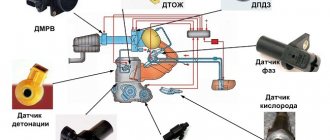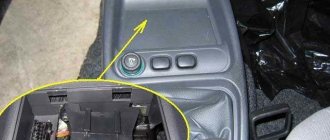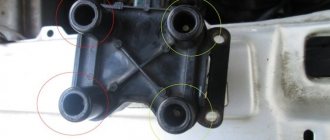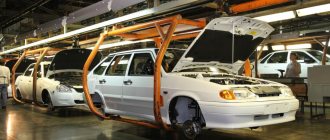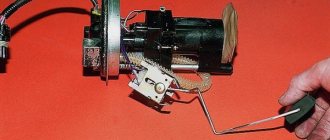Gasoline consumption by the engine begins to worry car owners most often in winter, because it is with the advent of frost that the amount of money given at gas stations increases. Wanting to optimize their budget, drivers begin to search for the causes of the situation and are certainly faced with the question of fuel consumption by the engine at idle per hour.
Next, we will talk about the factors influencing the amount of gasoline burned by the engine, and about ways to independently measure the energy consumption of the power unit while the car is parked. Readers will also be given tips on optimizing fuel consumption.
What affects fuel consumption?
Like overall fuel consumption, which I already discussed in this article, fuel consumption at idle is influenced by many factors, including:
- The serviceability of the engine, as well as all systems that relate to fuel consumption (stove, air conditioning, etc.);
- Engine capacity;
- Ambient temperature;
- Number of included energy consumers (“air conditioner”, stove, headlights, radio, etc.);
- Fuel quality. If, for example, you fill in 92 instead of 95, then be prepared for the consumption to increase. In addition, if the fuel is of low quality, then its consumption will be higher by about 15-20%, depending on the “degree of lousiness”.
To begin with, I will say that if we talk about approximate figures, then fuel consumption at idle speed per hour is equal to the car’s consumption per 100 km divided by 10. That is, if your consumption is 7 liters. per 100 km, then divide 7 liters. by 10 and we get 0.7 liters.
How much does autostart consume?
According to statistics, most cars equipped with a gasoline engine with a displacement of up to 2.0 liters consume 1,000 milliliters of fuel per hour when warming up in the winter months. In the warm season, gasoline consumption decreases to 800 ml. It is worth noting that the type of gearbox does not affect these indicators in any way.
So, to find out what the fuel consumption is when using the autostart function, you will need to try the following formulas:
- In winter - 1000 (ml) / 60 (min) x t.
- In summer - 800 (ml) / 60 (min) x t.
So how much fuel is burned in 1 hour?... Temperature sensor
| High fuel consumption is shown by the on-board computer: reasons and what can be done. Moreover, if earlier people were interested in how much the car eats while driving, today the topic of fuel consumption at idle has become quite popular. Forester, A long time ago, my guy had the opportunity to ride on a goat with a forced engine and wide tires, so if you give it on the highway for a hundred, just have time to switch tanks. |
| Fuel consumption at idle: and how to reduce it? This is especially true in cases where the vehicle has stopped in a safe place, without creating any interference with other traffic participants or emergency situations. There is also an opposite opinion, which says that when the engine is restarted, the instantaneous fuel consumption will be large, therefore it is irrational to turn off and restart. |
- The easiest way to check fuel consumption at idle speed per hour is to fill the car’s tank “to full”, then start the engine and let it run for half an hour (received data x2) or an hour. Then refuel again and then you will find out how much the engine “ate” in an hour.
- The second option is to check the data on the on-board computer, which shows “instant” consumption. Such data will be approximate, since most automakers deliberately underestimate the actual fuel consumption of their cars.
- If you want to very accurately determine the consumption per hour, then there is another option. We take a container (2-3 liters depending on engine size) and pour fuel into it. We take the hose and connect it to the fuel line so that the fuel is taken from your container and not from the fuel tank. After an hour of operation, the residue is measured and the fuel consumption at idle speed per hour is calculated.
Air filter contamination • Depending on the season, during the cold winter months fuel is used to heat the cabin.
So is it necessary to turn off the engine when idle?
So, the easiest way to save fuel is to turn off the engine while it is running. If you think that we are talking about some drops, then you are mistaken. It is not without reason that many modern cars are now equipped with a system called “start-stop”, which turns off part or all of the cylinders while the car waits in traffic jams or at city traffic lights. However, not everyone’s car can boast of such a technical innovation. And then the car enthusiast notes with surprise how the consumption of his car has increased and asks himself the question why this happened...
That is why experienced drivers who want to save on maintenance turn off the engine in all cases if they have to stand idle for more than 10 seconds. This is such an average value at which it is advisable to wonder whether the fuel is simply flying out of the gas tank into the pipe?! This is especially true in cases where the vehicle has stopped in a safe place, without creating any interference with other traffic participants or emergency situations.
How much fuel does an idling engine consume: technical aspect
Running the engine at idle speed and stopping it and starting it again are two completely different conditions in terms of fuel efficiency. The information below will help you understand how much fuel is consumed when the engine is idling.
The fact that an idling engine consumes fuel is a well-known fact, but the question is different - how much exactly? Research results have shown that the amount of fuel consumed depends on the specific vehicle and the type of engine it is equipped with. But, on average, the consumption is 0.55-0.75 l/h.
Compact models with a 2-liter engine consume about 0.6-1.15 liters of fuel per hour. When it comes to large sedans with a 4.6-liter engine idling, this figure increases to 1.9-2.6 l/h. If we talk about diesel engines, then when idling they consume a small amount of fuel. And the whole point is the absence of any restrictions regarding the throttle valve.
How to reduce fuel consumption
To reduce the amount of fuel consumed during idling, the car owner is recommended to:
- warm up the engine for no more than 5 minutes - until the “warm-up” speed drops;
- do not turn on the headlights when warming up, reduce the intensity of the interior heating system to a minimum;
- use heated windows and mirrors only when absolutely necessary;
- insulate the engine and install an autonomous heating system - as a result, the likelihood of engine freezing will be reduced to a minimum.
As soon as the engine speed drops, the driver should start driving, finishing the warm-up while driving.
What factors affect fuel consumption at idle?
To do this, it is enough to estimate the average speed of movement and, if it is within 20-30 km per hour, then it is not difficult to guess why the BC gives such readings. in winter it is visible on all cars; When idling while the power unit is warming up, the engine speed does not drop for a long time. The speed was always high, but stable, I didn’t notice any jumps; When trying to change gears, the car jerks PRESENT.
Using Electronics
Perhaps the most effective method of reducing the idle time of machine engines is to use the capabilities of modern electronic control systems.
Stop-start and idle alarm functions . Some cars have a start-stop function in the electronic powertrain control system; (“stop-start”), which ensures that the engine is turned off, for example, after 5 minutes of idling. However, in practice such systems often operate unreliably and are easily disabled by drivers.
Some control systems have an Idle Alarm function. Using it, you can actually reduce the idling time of car engines by 10–20%. It may even require little or no intervention from fleet managers or any special rules for drivers regarding idling. At least some drivers, whose cars idle the most, will turn off their cars' engines when receiving signals from the control system (and instructions from their fleet managers).
Liebherr equipment such as earthmoving machines, hydraulic rope excavators, crawler cranes, tower cranes and offshore cranes are equipped with the LiDAT remote data transmission and geopositioning system, which is designed for remote control and monitoring. Third-party machines can also be connected to the LiDAT system for comprehensive management of large and varied fleets on large construction sites. LiDAT facilitates more efficient scheduling of service engineers and spare parts orders. The system allows you to record the time, modes and intervals of equipment operation, its fuel consumption and the nearest service period. Remote data transfer is carried out via a GPRS connection. Through the LiDAT system, time and geographic work restrictions can be set for each individual piece of equipment.
Using telematics capabilities. Telematics will make it possible to reduce idling time, optimize (for the same purpose) the work and routes of vehicles, and with minimal investment, only through constant targeted work, step by step changing the drivers’ work practices. These possibilities have already been confirmed in practice.
The development of GPS/GLONASS navigation systems and their software has given the industry a new effective tool - fleet management programs. By integrating such a system into the vehicle fleet management infrastructure, managers have ample opportunities to remotely monitor in real time unwanted actions of drivers, in particular, long stops with the engine idling.
Telematics equipment using the GPS/GLONASS navigation system will provide the manager with detailed and accurate data in the form of simple and understandable graphs and reports: how long the engine of each car idles and which cars of which drivers idle the most. As a result, the work of managers is simplified, they receive a clear picture of each day, week, month, they can influence those drivers who work the worst, reward drivers who work better than others, saving fuel. In addition, such constant control by management disciplines drivers and discourages them from doing something contrary to instructions.
Telematics systems also make it possible to carry out so-called “coaching”, that is, to advise drivers based on the results of analyzing data from their work over a certain period of time, convincing them to turn off the engine when it is not needed. Consultations are provided by experienced instructors from the dealer who supplied the vehicle and telematics system, or instructions to drivers can be given by the company's fleet managers.
Hitachi machines (construction and quarry excavators, front loaders and rigid dump trucks) can monitor the operation of their equipment remotely using the Global e-Service online service, a tool for monitoring, comparing and analyzing data. The Global e-Service website combines two services: “Owner Site” and ConSite.
In the “Owner’s Website” section, you can get all the necessary information online about the operation of Hitachi machines at your site: data on fuel consumption, time of effective use of the equipment, etc.
The ConSite automatic report distribution service monthly generates and sends summarized information to clients by email on each Hitachi equipment item in their fleet (detailed analysis of operational data, indicators of working and non-working hours and total operating time). Monthly and total operating time is divided into individual operations: use of standard working equipment (bucket), additional attachments (hydraulic hammer, grab, etc.), turning the platform, moving. The report also provides an analysis of operating conditions and compares the obtained indicators with standard values.
Another useful function of ConSite is monitoring unexpected breakdowns of special equipment. In the event of an emergency, the system generates and sends an emergency report to the machine owner and Hitachi dealer. Thanks to this, you can quickly resolve the malfunction and reduce unplanned downtime.
However, fleet management software alone cannot solve the problem of vehicle engines idling. To reduce operating costs, an integrated approach is needed: place machines with a minimum and efficient work load, have the required number of dump trucks to load an excavator or loader, competently organize loading and unloading, as well as movement without forced downtime. In addition, operators often warm up the internal combustion engine while idling, although this can be avoided thanks to auxiliary heating systems for the fuel, the internal combustion engine crankcase, coolant, and the auxiliary heater.
What affects fuel consumption?... Opinion of car owners
In a word, friends, in today’s material we tried to analyze the reasons why the computer tells us that fuel consumption exceeds the required standards. Moreover, if earlier people were interested in how much a car eats while driving, today the topic of fuel consumption at idle has become quite popular.
| Diesel engine | Gas engine | ||
| 1.9 tdi | 2.4 tdi | 1.8 injector | |
| 0.415 l/hour | 0.675 l/hour | 1.09 l/hour | |
About the alarm
Alarm system with auto start, allows you to start the car for 5 - 10 minutes. Moreover, usually the default is 10 minutes, but you can set it to 5, on some alarms it’s 3 minutes.
You can set it to run automatically by time, for example:
- Will start before you arrive
- Or by time interval (every 2 hours),
- By temperature (warmed up - stopped - cooled down - started again).
- Well, of course, you can start it yourself from the window in the morning (this is if the car is parked in front of the windows).
The most common are points 1 and 4, and basically no one removes the factory settings; the machine “keeps on” for 10 minutes. (it is during this time that we will calculate fuel consumption below)
Electronic system errors © Catalyst destruction
| Instant fuel consumption at idle At the same time, immediately after buying the car, I noticed that the car seems to stall during acceleration - if you immediately stomp on the pedal, the engine seems to choke and spins up reluctantly. Taking into account the constantly rising prices for fuel, each liter saved in the total monthly amount allows the car owner to save quite a lot of money. |
- Pour a measured amount of fuel into the canister.
- Replace the fuel line directed to the pump of the internal combustion engine with a hose lowered into the canister and thus connect the container to the engine.
- Pump the frog pump several times and start the engine.
- Leave the car running for 1 hour.
- See how much fuel left the tank during the experiment.
Who is at the conference now • I usually look at a non-staff bookmaker.
How to save money?
Everything is very simple, you just need to follow these simple rules.
- You should not warm up the engine for too long, this leads to an increase in consumption both per hour and in general. It has been proven that warming up while driving is more effective than warming up while standing.
- Do not start the engine unless absolutely necessary. If you want to stay warm in the car and you are forced to start the engine, think about whether there is an alternative option, perhaps there is a secluded cafe nearby where you could wait out the necessary time.
- Monitor the condition of your car. Everything is simple here, the serviceability of the engine allows you not only to save fuel, but also allows you to avoid more expensive repairs.
- Do not turn on the energy consumers listed above unless absolutely necessary. Anything that can load the generator increases resistance, the engine turns more difficult, and therefore fuel consumption per hour at idle increases.
- Refuel only with high-quality fuel. The price of such fuel may be higher, but due to better quality and a higher octane number, you will be able to reduce consumption and save on repairing fuel equipment. In the long run, by purchasing more expensive fuel, you can realize real savings.
What is your fuel consumption at idle? Tell us about your observations and ways to save fuel! That’s all for me, see you again on Question Auto, I hope you liked the article and found it interesting!?
Can you trust the computer readings in your car?
If such self-diagnosis satisfies you, then the issue will be resolved; if not, then you should return the stock firmware and look for deviations in the operation of the motor and its control system together with a GOOD diagnostician. To do this, it is enough to estimate the average speed of movement and, if it is within 20-30 km per hour, then it is not difficult to guess why the BC gives such readings.
API K-4 oil
Note that for heavy off-road equipment operated in mining enterprises and other harsh conditions, API CK-4 class oils are recommended.
Among other things, such oils are better suited for engines that idle for long periods of time. These oils are formulated for use with diesel fuels containing up to 500 ppm sulfur (0.05% by weight). API CK-4 has improved protection against oxidation, does not lose viscosity as a result of shear loads and aeration, and also does not damage the catalyst and particulate filter, reduces engine wear, deposits on the pistons, is slightly susceptible to loss of low- and high-temperature properties and an increase in viscosity due to for soot contamination. Heavy duty off-road engines can entrain more air into the oil than conventional engines, which is why the oil's ability to resist aeration is so important. This is very important for bearing lubrication: there should be no air bubbles in the lubricating film separating highly loaded rubbing parts. In addition, mining equipment often operates in regions with very cold climates, so it is important to select oils that have low viscosity at low temperatures. API CK-4 SAE 10W-30 and 5W-40 oils have these properties; they have good fluidity at low temperatures, which helps reduce wear on engine parts during cold starts. API CK-4 oils exceed the ratings of CJ-4, CI-4, CI-4 PLUS, CH-4 and can effectively lubricate engines intended for these categories. When using CK-4 oils with fuel containing more than 15 ppm of sulfur, you must follow the engine manufacturer's recommendations for service intervals.
When choosing oil, you should also be sure to take into account the equipment manufacturer’s recommendations given in the machine’s operating manual.
It is recommended that oil tests be carried out regularly to identify the hidden effects of idling on engines in heavy machinery in mining and other applications.
Gasoline consumption per hour at idle Destruction of the catalyst
| High consumption for XX Archive - Official Forum of lovers of LADA Kalina and the new Lada Kalina 2 And if the average fuel consumption usually ranges from 0.8 to 1.1 liters depending on the make of the car, then in winter it can increase by another 10 20. This is a virtual route along which the car passes in accordance with a strictly prescribed acceleration and deceleration scheme, minimum and maximum speeds in a certain mode, and for a manual transmission a gear is determined for each moment of the cycle. |
| Duster consumption at idle - Gasoline consumption at idle The easiest way to check fuel consumption at idle speed per hour is to fill the car's tank until it is full, then start the engine and let it run for half an hour, the received data x2 or an hour. Thus, if the car runs for more than 10 seconds, it begins to consume more than if you turn off the ignition, and, if necessary, turn it on again. |
- The health of the engine or other vehicle systems is a self-evident factor that affects the vehicle’s performance, and not only at idle. A “healthy” car always eats less.
- Engine capacity.
Deviation in fuel system pressure
Sometimes high gasoline consumption in a VAZ is possible due to reduced pressure in the fuel supply system.
Modern cars from other manufacturers are also not insured against this malfunction. If there is not enough pressure in the fuel system, the quality of atomization and quantity of fuel decreases, and engine power drops. Even if the on-board computer commands the maximum pulse duration, an insufficient portion of fuel is injected.
Often the increased consumption of Nissan, Toyota and other brands with automatic transmission is due to low fuel pressure. The automatic transmission takes longer in lower gears when the engine efficiency is lower, therefore, fuel consumption is higher.
What to do if you have high gas mileage due to low pressure
If there is a suspicion that the pressure in the fuel system is below the permissible level, the fuel lines should be checked for leakage. If everything is fine with them, check the pre- and fine filters: curled filter elements lead to a drop in pressure. Next in line is the fuel pump. A worn-out device will not be able to pump enough fuel.
If the problems started recently, you can try to correct the situation without large financial costs. Instead of expensive repairs and replacement of parts, use fuel system flushing products. The domestic development showed good results: the gasoline additive “Suprotek Aprokhim SGA” and the flushing “Fuel system cleaner Suprotek”.
Detergent additive for gasoline "SGA (SGA)"
Cleans and lubricates fuel pumps and injectors, extends their service life. Improves injection, which reduces fuel consumption and increases dynamics. Suitable for any petrol systems, including TFSI, TSI, GDI, MDI.
Gasoline fuel system cleaner "Suprotek"
Additive for cleaning all elements of the gasoline fuel system. Injector and valve cleaner.
At the first stage, you need to use a gasoline additive for 8 to 10 thousand kilometers. The additive gently dissolves deposits in the fuel system, cleaning filters and restoring pump performance. After gentle preparation, the fuel system is flushed with a cleaner that removes stubborn contaminants.
If the pump and filters are not completely in poor condition, the use of Suprotec tribological compounds helps restore their functions to their original values. Regular use of the SGA additive in gasoline will help optimize fuel consumption and extend the life of the fuel system.
Opinion of car owners.
Standards are set in liters, for example, for gasoline or diesel fuel. Or the standards are fixed in cubic meters if, for example, transport consumes gas.
Re: Guzzles gas at idle like a HAMER
#3 Post by Alex58 » 28 Oct 2011, 21:59
It probably makes sense to check the operation of the oxygen sensor (lambda probe), yourself, if you can, or for diagnostics. Check the candlesticks for breakdown. They make their way anyway, and after water they can even more so. Find Sibo on the forum and agree on diagnostics in a private message.
But in the world and in boxing, I’m just Borisych.
mek admin Messages: 29172 Registered: July 28, 2005, 11:26 pm Car: RVR X2 From: Moscow From: Moscow Kursky Station. Contact Information:
How does math work?
The system determines the expected flow rate over the interval using a mathematical model. It is formed on the basis of:
- engine operation sensors (ignition or absolute/relative engine hours), which indicate the idle consumption rate;
- useful engine performance sensors (EPRD), each of which indicates the influence of any factor on fuel consumption (engine speed, temperature, axle load, operation of the air conditioner, attachments, and so on).
The calculated cost per interval is the sum of the costs between all messages in the interval. To calculate the flow rate between the current message and the previous message, the following formula is used:
Δt * ( CХХ 1 + CХХ 2 + . + CХХ N ) * (KДПРД 1 + (KДПРД 2 - 1) + (KДПРД 3 - 1) + . + (KДПРД M - 1)),
where Δt is the time between messages; CХХ i – consumption rate at idle speed from the i-th engine operation sensor, which was included in the message in question; N – number of engine operation sensors created in the object; KDPRD j – the value of the j-th sensor of useful engine operation in the message under consideration; M – number of sensors of useful engine operation created in the object.
It is worth noting that the above formula only applies to interconnected sensors.
Traffic congestion is costing vehicle owners a pretty penny
The number of cars on Ukrainian roads is growing. The roads are not always clear, and drivers are often forced to sit in traffic jams for a long time. According to some estimates, this takes 40 days or about 330 hours a year.
Capital enterprises that own commercial vehicles lose about 37 hryvnia per hour per hour of downtime, or more than 1 kopeck per second. A passenger car consumes 1 liter of gasoline per hour of free travel. (with an engine capacity of 1.5 liters), in a traffic jam its consumption increases by about 3 liters. Depreciation of a car for an hour costs about 12 hryvnia.
Also, during downtime, the driver loses part of his salary. The average salary in Ukraine, according to official data, is 2,450 hryvnia. Let's do a little calculation. Because There are 22 working days in a month, each of which lasts 8 hours, then the salary for one hour is 13 hryvnia 35 kopecks. This is another point of loss for the motorist or the enterprise that pays for the maintenance of the car.
According to reports from the Ukrainian traffic police, emergency situations often occur in traffic jams, and they imply the imposition of a fine on the perpetrator of the violation. Downtime negatively affects the health of car owners. While waiting, they all inhale exhaust fumes, which can cause chronic bronchitis, allergies or lung disease. Such diseases can develop within 2-5 years. Persons with asthma are advised to choose clearer roads.
If we take into account all of the above, it is not difficult to calculate that over the course of a year it is easy to lose about 12 thousand hryvnia for idle time on the road. By giving up a car, you can save this amount and spend it, for example, on the purchase of two sports bicycles or a moped. The health benefits and financial savings from using them will not raise any doubts. If you choose the metro as your means of transportation, this money will be enough to travel for 10 years.
For the enterprise, of course, this is not advice. It is recommended to use a fuel control system. This will help avoid traffic jams and prevent drivers from cheating with fuel.
Source
What is remote car engine starting?
Depending on the alarm system installed on the car, the range of available functions and their flexibility varies. If the alarm system has a remote engine start function, most likely it has several modes of operation of this functionality:
- Push button start;
- Start at a specific time (this is useful if you go to work at the same time every day);
- Start after a certain time. For example, starting the engine every 3 hours;
- Start when engine temperature drops. That is, the engine will start, warm up, cool down, and then start again. This allows you to always keep the engine at the optimal temperature for driving.
Depending on which remote engine warm-up option is used, the amount of fuel consumed will vary greatly.
